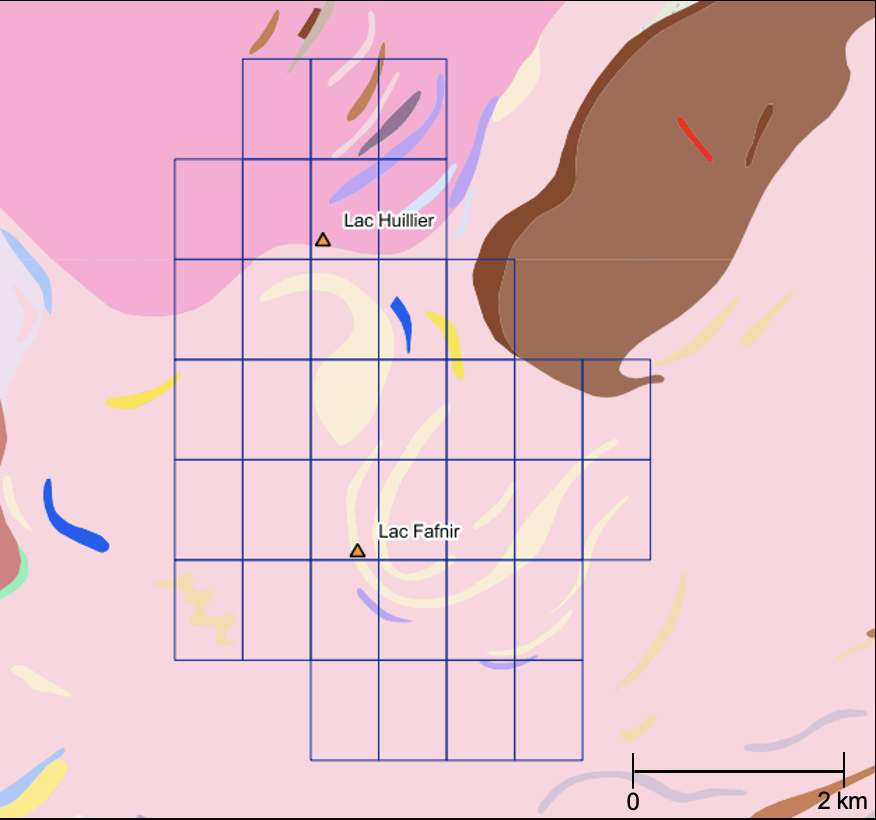The Fafnir Lake Property consists of 36 claims covering 2,102 hectares (21 km2). The property is comprised of the Huillier Lake and Fafnir Lake showings.
Location: The Fafnir Lake Property Polymetallic Property is located 75 km due north of the town of Mont-Laurier in the Upper Laurentians region and can be accessed through Highways 117 and 309, and a network of well maintained secondary and lumber roads.

The Property consists of an assemblage of monzonite, quartzo-feldspathic gneisses, calcsilicate rocks and quartzite that are crosscut by numerous late stage light-coloured pegmatites. These pegmatites are oriented North-South and can be followed over a distance of at least 4 km. Despite good access, geological mapping remains piecemeal and patchy as several additional pegmatite bodies are likely to be discovered through detailed prospecting. Two important shear zones, 25 km apart, are present in the vicinity of Fafnir Lake: The north-northeast oriented Gatineau Shear Zone located roughly 15 km north of the Property and the northeast oriented Reymont Shear Zone located 5 km south of the Property.
There is a north-south structural feature connecting both shear zones. Pegmatites are parallel and on trend to this feature.
Discovered in 1968 and never followed-up, the Huillier Lake showing is nearly 3 km north of the Fafnir Lake showing and consists of at least 5 light colored and parallel pegmatite dykes, striking almost due north and dipping 10 to 20 degrees to the east. A total of 3 historical holes drilled from the Huillier showing crosscut several 0.3 to 0.6 metre wide intervals that assayed 0.06 to 0.11% U3O8.
In the early 2000’s, government geologists have mapped many new pegmatite outcrops along a northern trend between both Fafnir Lake and Huillier Lake showings. These pegmatite outcrops were never followed up for molybdenum, lead, or niobium despite similar geological features.
In December of 2024, the completed its initial outcrop sampling program on its 100% owned Fafnir Lake Uranium and Molybdenum Property, located in the Upper Laurentides region of Quebec. The Company carried out detailed outcrop sampling in an area roughly 4 km by 1 km encompassing both the Fafnir Lake and Huillier Lake showings which are nearly 3 km apart.
Prospecting at Fafnir was completed in November 2024 as 41 rock samples were sent for critical element assays, including uranium, molybdenum and Rare Earth Elements which allowed to better outline the area of interest at approximately 3 km to 500 to 700 metres wide, oriented north-south within the Fafnir Property. West and east of that zone of interest, the percentage and number of pegmatites are decreasing rapidly. Nearly 100 outcrops were mapped, including the Fafnir showing and most mineralized and reported outcrops within this area of interest. Unfortunately, the Huillier showing, identified and reported in 1968, may have not been sampled.
Although sulfides were not observed in most samples, few samples had sulfides up to 5% either in pegmatites and paragneisses. Black and dark minerals are often present in pegmatites and allanite, a Rare Earth Element, was positively observed. Results yielded no uranium value of interest and only anomalous Rare Earth Elements values were returned. However, based on field observations, it appeared that both Fafnir and Huilier Lake showings were several hundred metres west and could not thus be sampled.